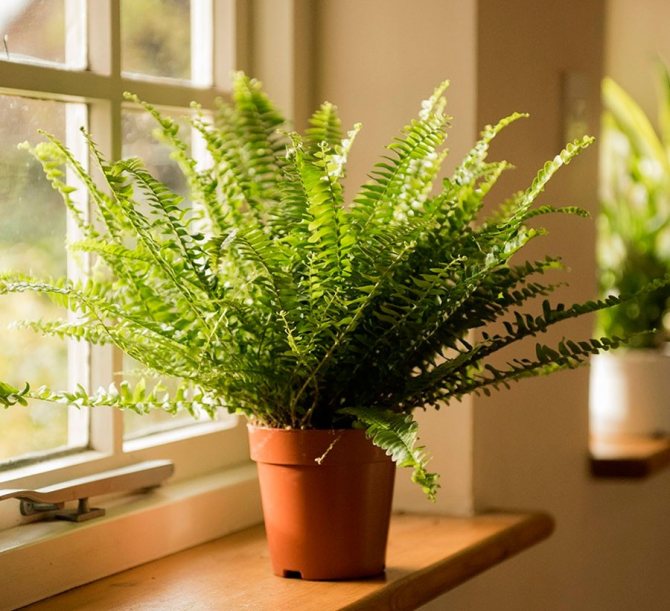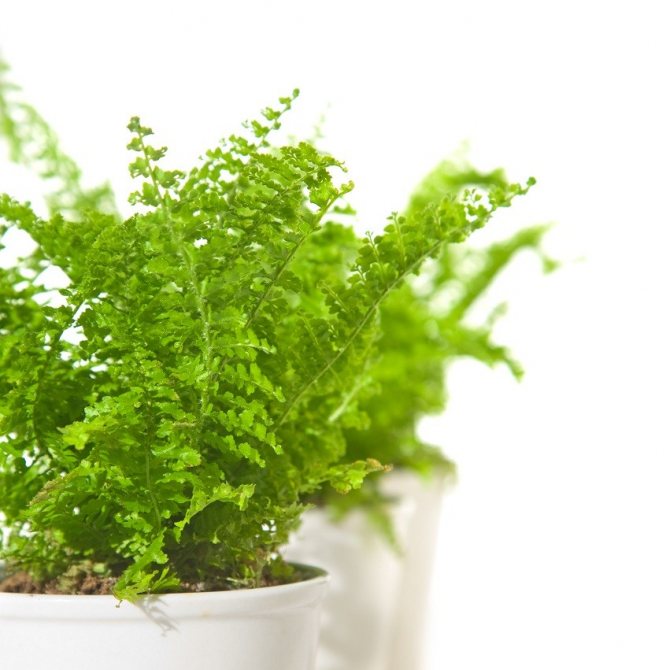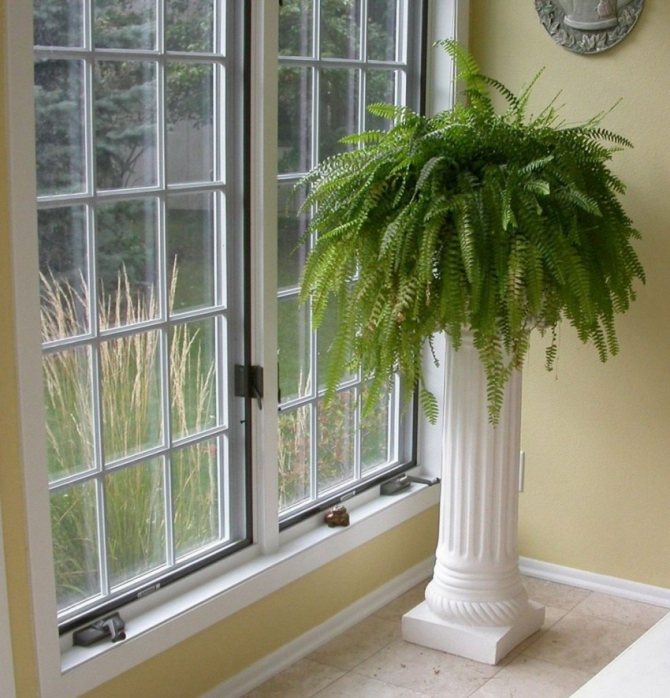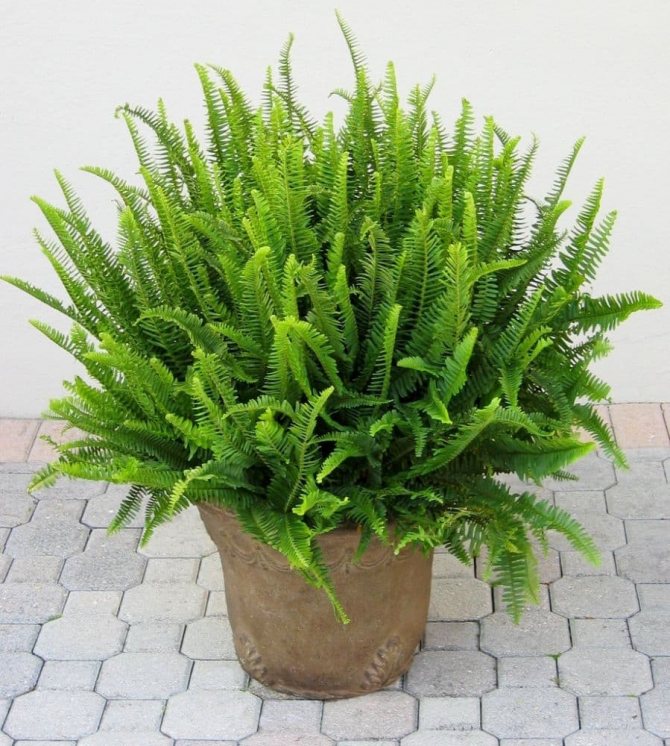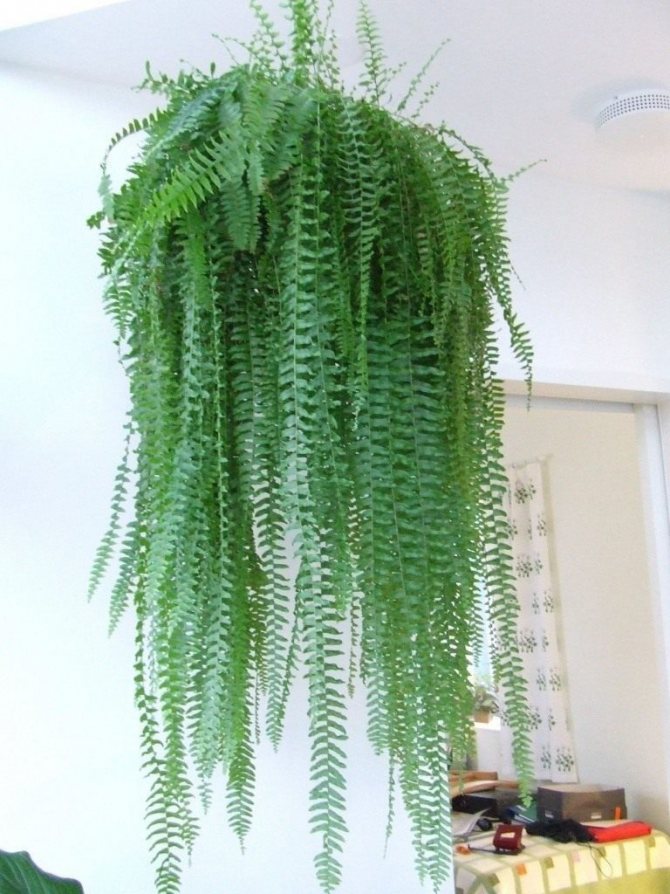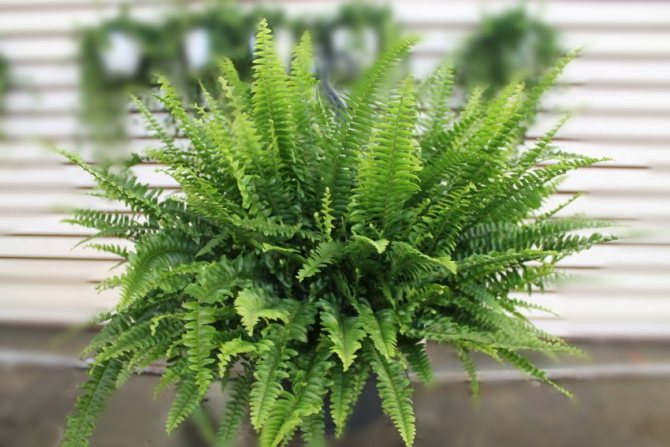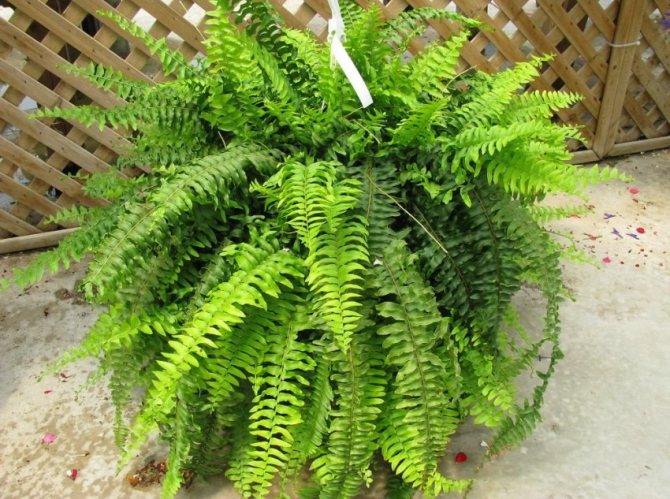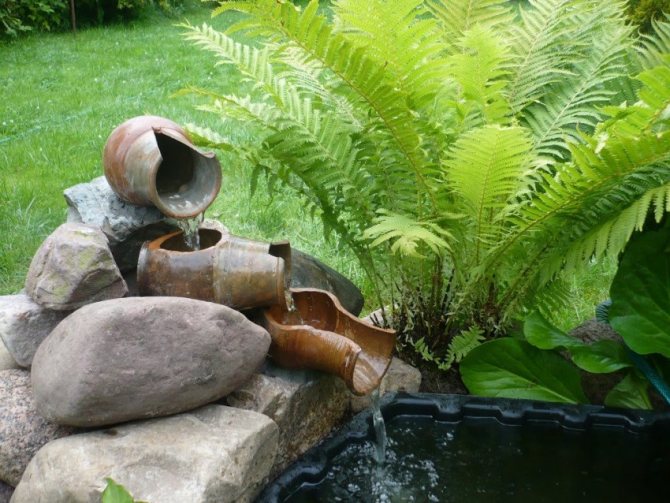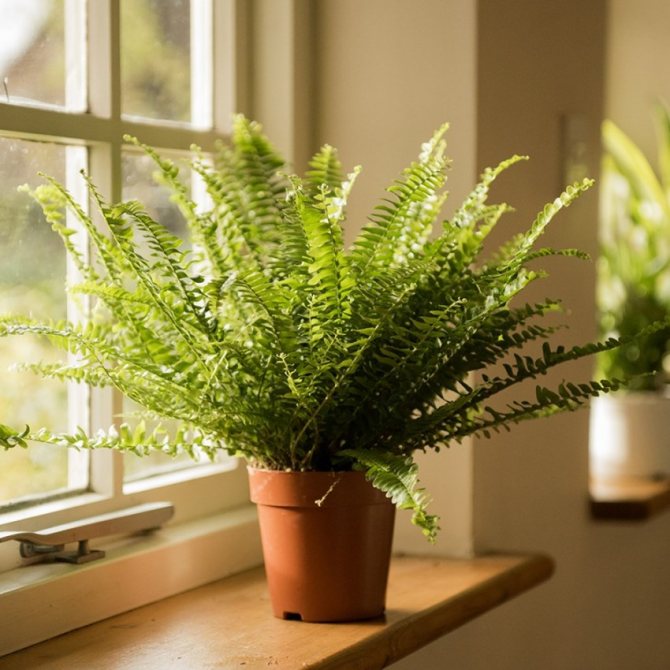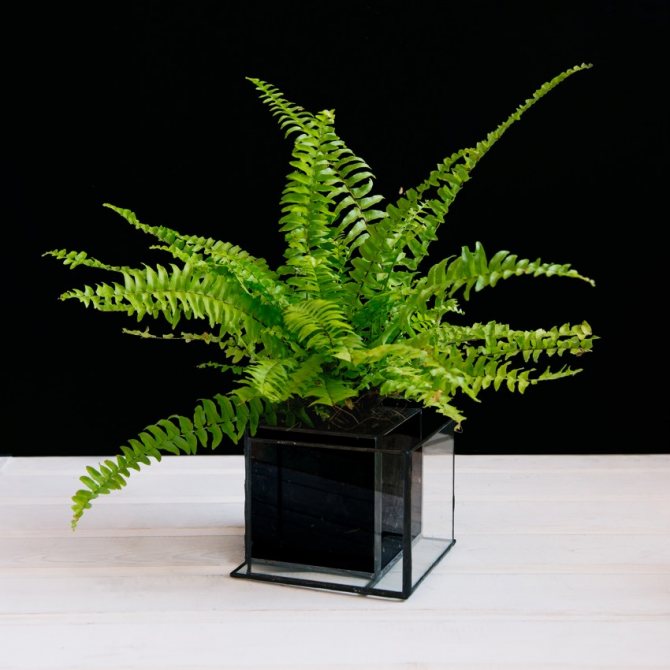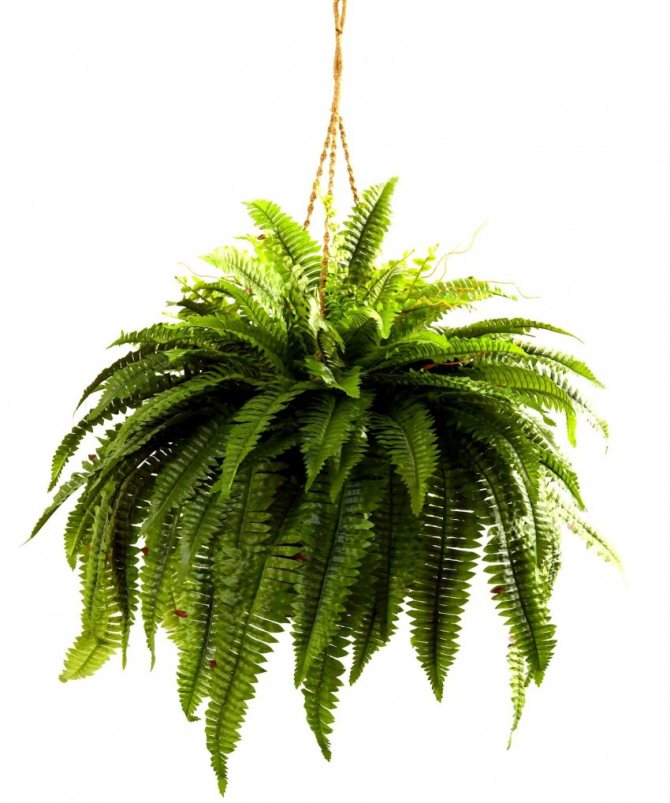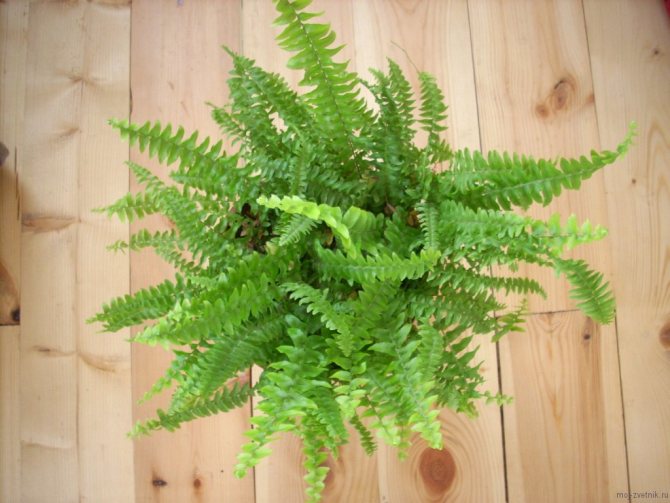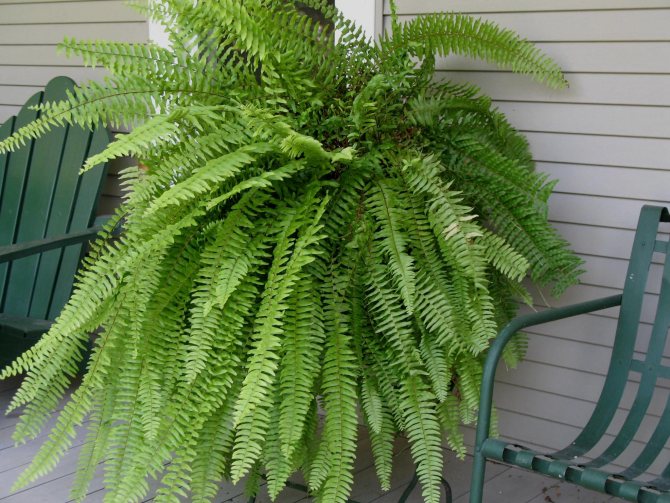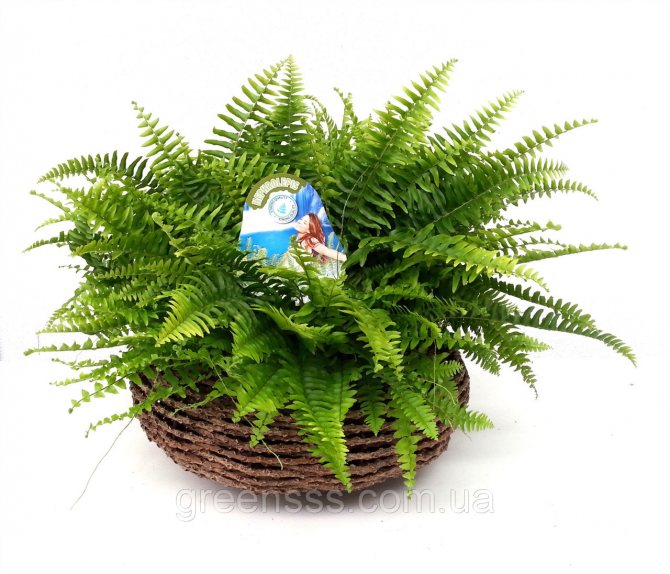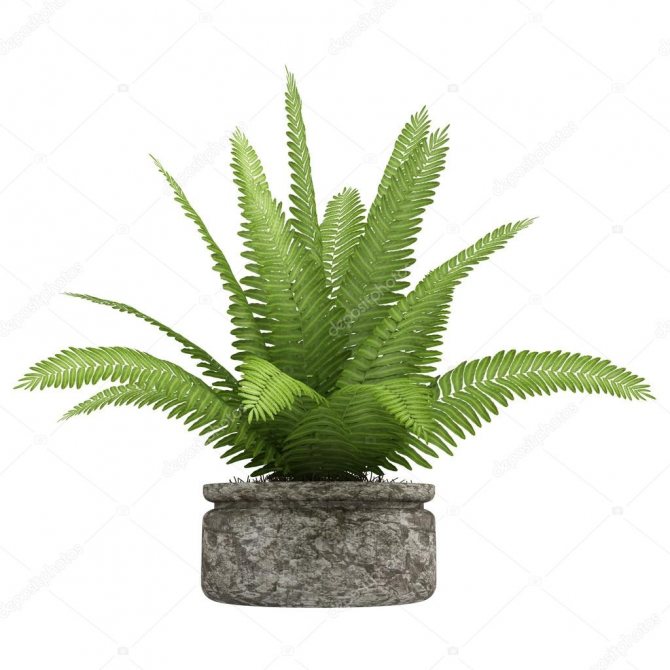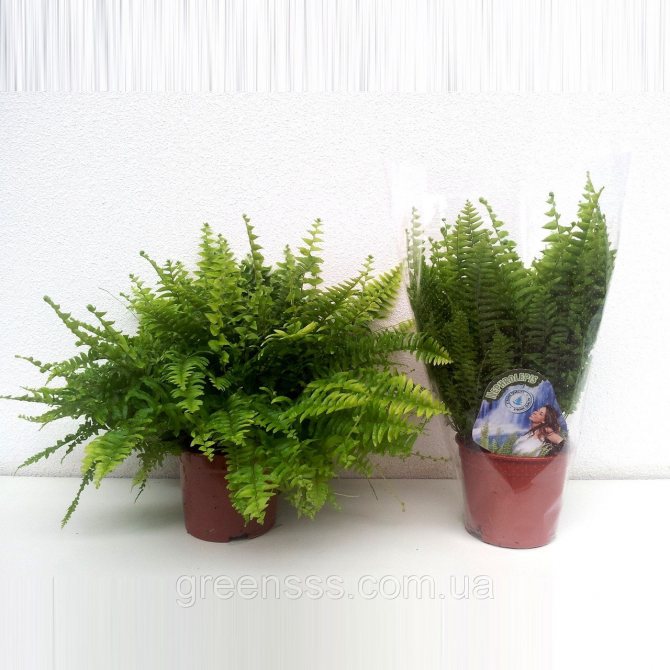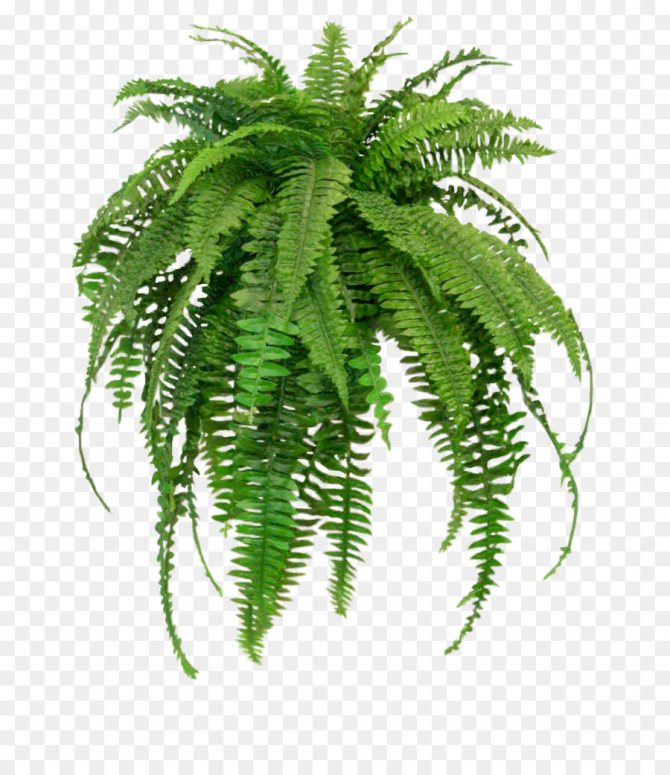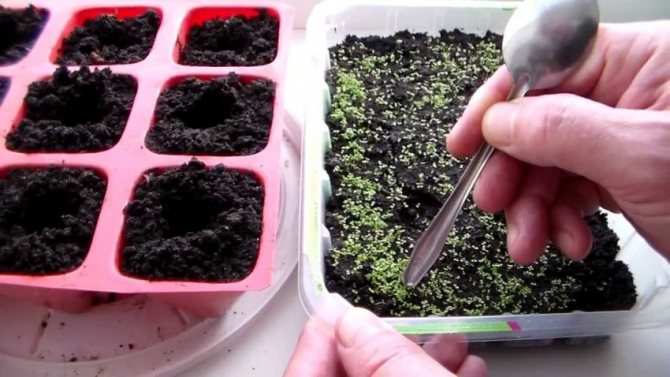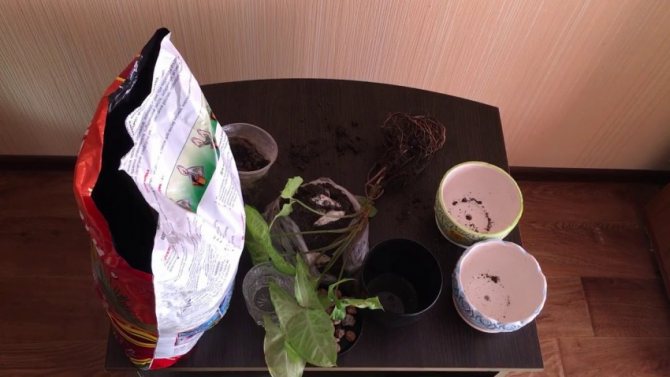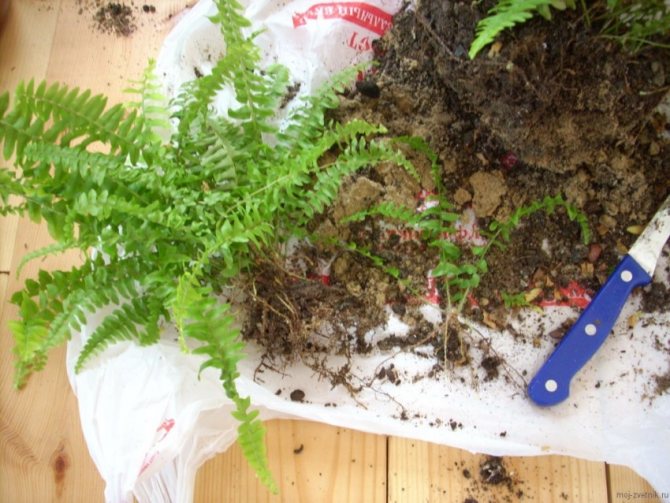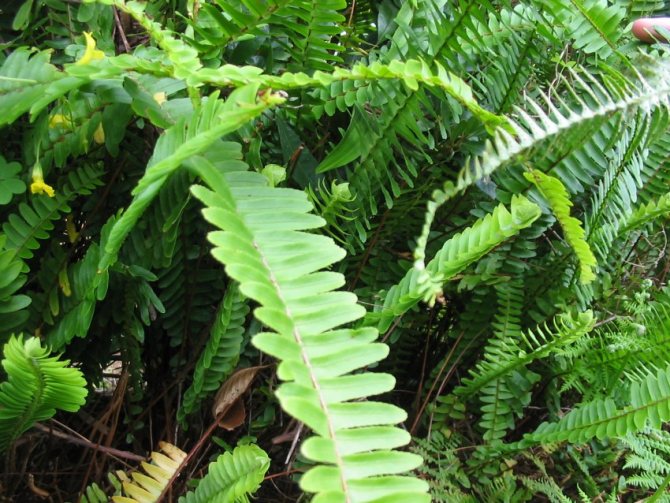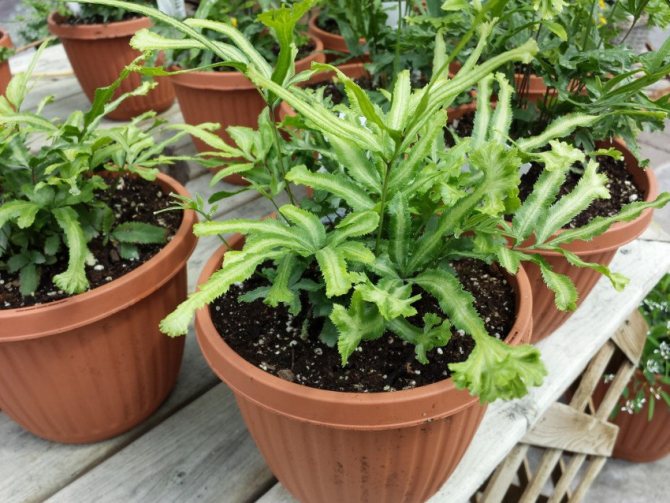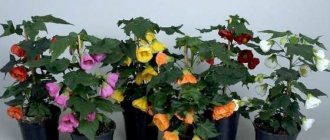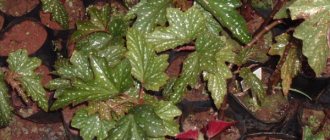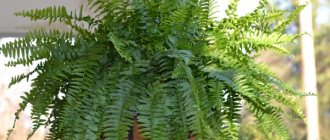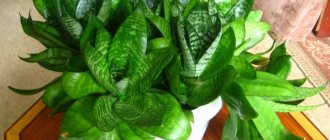Nephrolepis (Nephrolepis) is a herbaceous plant capable of leading a terrestrial or epiphytic mode of existence. Belongs to the genus Fern. The rhizome is short. The terrestrial part is represented by leaves (fronds), reaching lengths of up to 70 cm. Light green leaves consist of lanceolate segments with even or serrate-crenate edges.
The plant is widespread in the tropics and subtropics of Africa, America, southeast Asia.
When grown indoors, nephrolepis looks especially elegant in hanging pots or on stands.
In addition to beauty, the plant has useful properties: it purifies the air, is capable of absorbing harmful substances toluene and formaldehyde, and kills pathogenic microbes. Therefore, fern bushes can often be found in medical institutions.
Fern care
How to care for a fern at home? It is imperative to follow the rules of growing and caring for this plant.
Lighting and temperature control
When caring for this plant, it is necessary to provide it with good lighting, but so that direct sunlight does not fall on it. According to many growers, ferns are shade-tolerant shrubs. However, in the shade, such a plant stops growing and may die. In order for its leaves to remain healthy and large, diffused but bright light is required. It is advisable to put a pot with shrubs on a window overlooking the southeast side.
Indoor fern feels great indoors at an air temperature of 15 - 22 degrees. It should be noted that all fern varieties prefer well-ventilated rooms and do not tolerate drafts and cold air at all. In warmer months, shrub pots should be placed on the balcony or in the garden, not allowing direct sunlight to fall on them.
Indoor oxalis: home care
Air humidity and watering
Fern care at home involves adherence to a certain watering regime. Such a shrub should be watered regularly as soon as the top layer of the earth dries up slightly. The number of waterings depends on the temperature in the room. In the heat, the plant is watered several times a week. If the soil is overdried for a long time, then this negatively affects the fern.
You need to know that if a shrub spends several days in a dry earthen mixture, then after watering it will no longer recover. But an excessive amount of moisture is also detrimental to the roots of the plant. That is why it should be planted in well-drained soil so that excess moisture begins to drain immediately.
Water the bushes with soft water at room temperature. It is best if it is:
- settled for several days;
- boiled.
Domestic ferns prefer high air humidity. It is recommended to spray them every day. In hot weather or in a room with batteries turned on, shrubs must be sprayed several times a day or use a special air humidifier. In addition, you should take a shower from time to time.
Fertilizing products
Sometimes, during active growth, a houseplant fern does not receive nutrients in the required amount, so its leaves first begin to turn pale, after which they turn yellow and dry out. Therefore, the shrubs should be fed with special complex liquid fertilizers once a week.
The plant needs rest, so it should arrange such a period from late October to mid-February. If at this time the plant is in a cool room, then you need to stop feeding and reduce the amount of watering by half.
Plant transplant
Home care for a fern involves an annual transplant of young plants. Adult specimens should be replanted after the pot is completely filled with roots.
How to transplant indoor fern? The complexity of this procedure lies in the fact that such shrubs react extremely painfully to transplanting from one pot to another and recover for a long time after that. Therefore, the transplantation must be carried out by the transshipment method, when during the process the roots of the plant are not cleared of the earth. It is best to replant the fern in the spring. A wide and low flowerpot should be selected for it, and the acidity level of the soil should be 5.0 - 6.6 pH.
Fern soil is prepared by mixing:
- 1 part of peat, humus and leafy soil;
- 1/5 of bone meal.
The new pot should be 5 cm larger than the previous one, and drainage is poured onto its bottom, then moss is laid and the substrate is added. The shrub must be planted, and its roots must be covered with an earthen mixture in such a way that there are no voids between them. Immediately after this procedure, the plant is watered abundantly and continue to do so for another two weeks.
Signs and superstitions about nephrolepis Can I keep at home?
Fern is credited with magical properties that can influence fate. An ancient legend says that if on the night of Ivan Kupala you go in search of a fern flower, the seeker will expect various horrors. The one who finds the fern flower will find happiness in his personal life and wealth.
It is believed that the fern protects the house from evil spirits, and the inhabitants of the house will not be afraid of the evil eye and damage.
The ability to bring success in business life is noted: attracting money to the house, protection from irrational financial spending.
Fern nephrolepis is also called a plant of the golden mean due to its ability to mitigate aggressive behavior of people, smooth out conflict situations. The plant harmonizes relationships between people with different temperaments.
Botanical description and birthplace of the nephrolepis fern
The nephrolepis fern (Nephrolépis, lat.) Is a herbaceous plant from the genus of ferns (family Nephrolepidaceae), in other classifications it belongs to the davallium family. In the genus, there are about thirty herbaceous perennials with a habitat throughout the globe.
The plant is terrestrial, the root is short, pinnately compound leaves of a light green color form a rosette. The length of the leaves in most species reaches 70 cm, during life the leaves turn yellow and fall off naturally.
The homeland of nephrolepis is considered to be shady tropical forests in Australia, Africa, and Southeast Asia.
Photo gallery
Nephrolepis care
Temperature conditions. Moderate - warm content at a temperature of 16 to 18 ° C. At higher temperatures, it is imperative to increase the frequency of watering and the humidity of the air. Do not expose the plant to temperatures below 10 ° C. These ferns do not like abrupt changes in temperature conditions and intense heat, preferring rather cool conditions. With the onset of frost, all terrestrial plants often die.
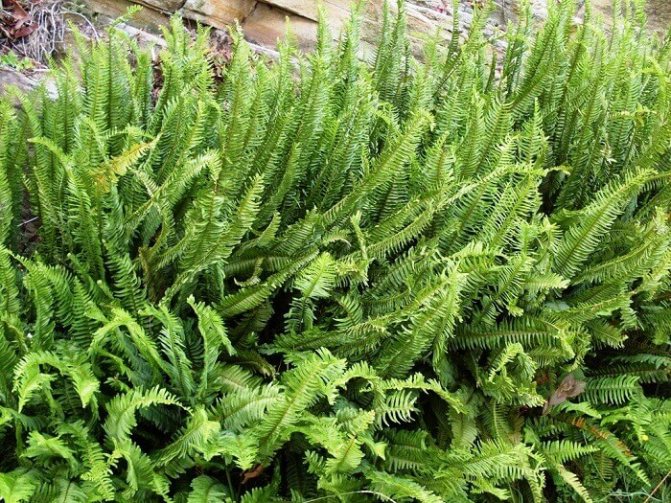
Indoor nephrolepis - lighting.Unlike most other indoor ferns, it can grow in bright sunlight, but not in direct sunlight. Transfers partial shade. For even growth, turn the plants each week in opposite directions to the light source.
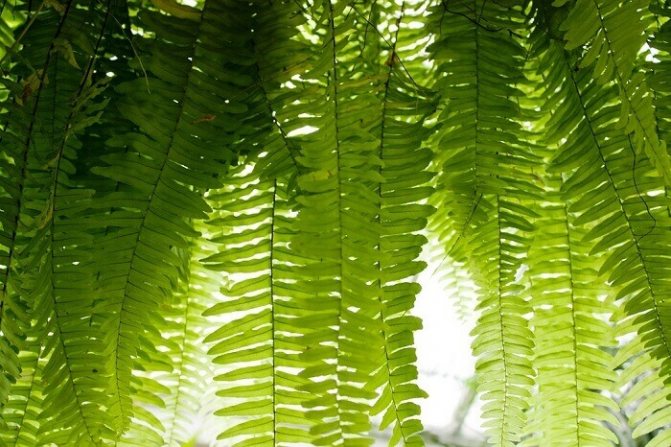

Nephrolepis at home. The nephrolepis flower is considered the fern most adapted to room culture, however, it also has its own requirements for keeping conditions. Provide the plant with increased air humidity, remove old, wilted branches. Cut out old and diseased leaves at the base. Bring nephrolepis to fresh air during the warmer months.
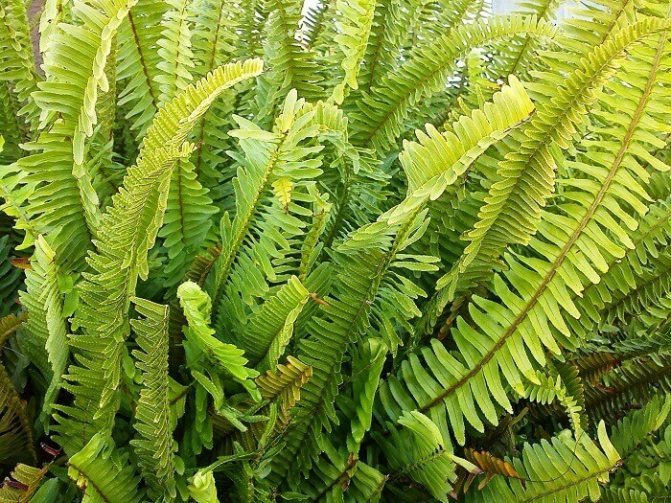

Primer for nephrolepis. A mixture of garden soil, leaf humus with the addition of small pieces of charcoal and coarse river sand. The soil should retain moisture for some time and contain a sufficient amount of organic matter.
Fertilizer for nephrolepis. Nephrolepis at home does not have a distinct dormant period and is able to grow all year round, so feed it at any time of the year every two weeks using liquid fertilizer diluted to half the recommended dose.


Appointment. An adult fern is a majestic plant, its fronds will hang in a beautiful cascade over the edge of a hanging basket. Feels great in bathrooms where the air humidity is high enough.
Flowering time. Does not bloom.
Air humidity. Dislikes drafts and placement near heating appliances. The humidity can be increased by placing the fern on a pallet of damp pebbles or by surrounding the pot with a layer of damp sphagnum moss. Spray the plant with room temperature water in the morning.


Nephrolepis watering. Keep the soil evenly moist, but not waterlogged. If the temperature of the content is less than 13 °, you can reduce the frequency of watering, but do not allow the soil to dry out. For watering, use only water at room temperature, since when watering with cold water, the plant can get sick. Add 1 - 2 tablespoons of table salt to 5 liters of water for irrigation and the leaves of nephrolepis will take on a bright emerald color. Such irrigation is used every six months. Periodic showers are helpful.
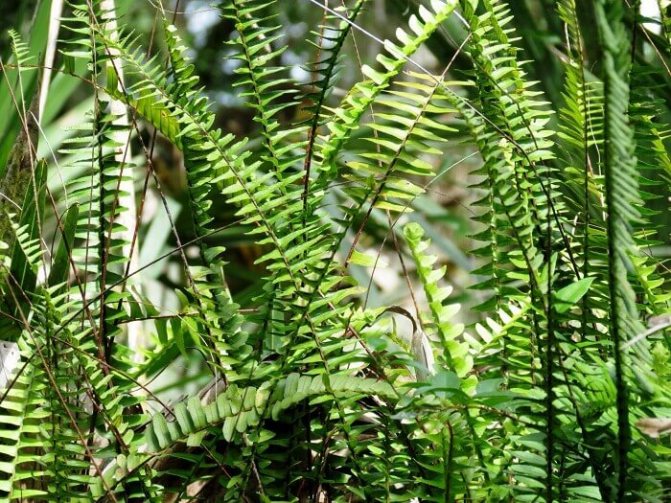

Nephrolepis transplant. In the spring, when the root system has filled the entire pot and the plant is frankly cramped. Nephrolepis inhibits development when grown in tight pots, but if planted in containers that are too large with a lot of free soil, the plants will rot. In large plants, the topsoil is replaced annually with a fresh one. If you want to teach a fairly compact plant, cut the root system when transplanting by ¼ of the length. A pot for nephrrolepis should have large drainage holes, and a drainage layer should be placed on its bottom. After planting, tamp the soil around the fern a little with your hands.
Watering, fertilizing
In warm summer, the fern needs daily watering. In winter, in autumn, you can reduce the number of watering. So that nephrolepis does not lose its growth rate, it must be sprayed daily and the earth must not be dry.
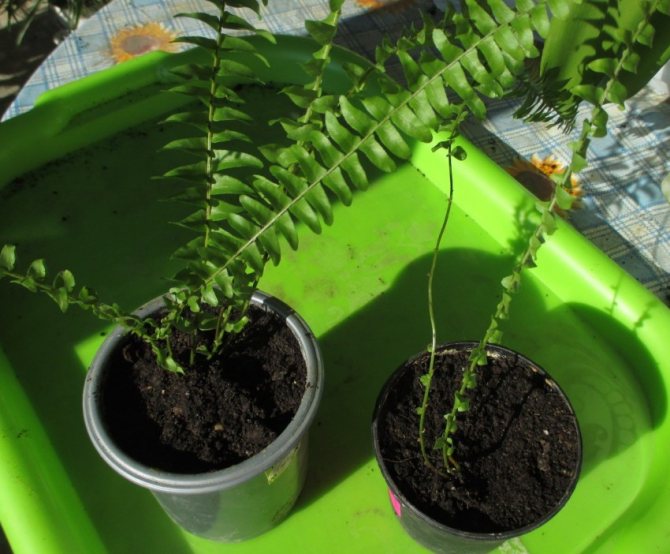

Fern needs to be fed in autumn and spring. As a top dressing, mineral and organic fertilizers are suitable, which must be alternated.
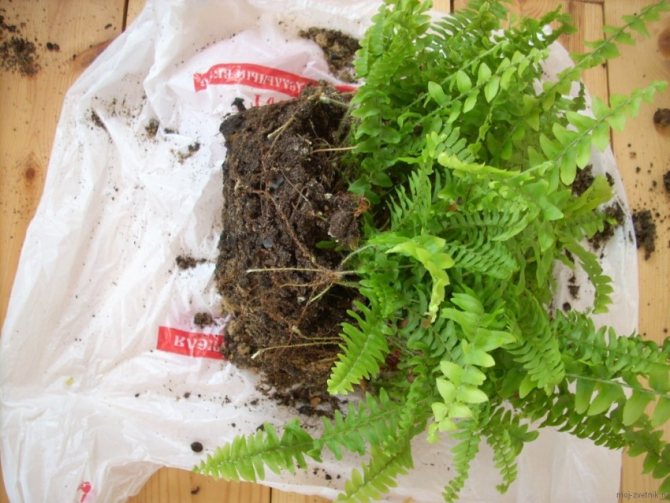

It is categorically impossible to fertilize nephrolepis in the cold season, from mid-autumn to the end of winter, in order to prevent the occurrence of pests. Concentrated fertilizers are not used.


Why do the leaves of nephrolepis dry
Growing nephrolepis, a florist may face certain difficulties. One of the most common problems is the drying out of the leaf plates. Leaves can dry for various reasons, but most often this is due to improper moisture and infection of the fern with diseases and pests.
Optimal hydration
Drying of the plates may be due to a lack of moisture. From a small amount of water or occasional watering, the leaves dry completely. Sometimes, before drying, the plates of fern leaves can change: change the usual color to brown, curl up, wither.
Such transformations indicate a violation not only of the water balance of nephrolepis, but also of the temperature regime of its content. Similar changes occur due to cold watering. If only the tips of the leaves dry, this indicates a low level of humidity in the air around the flower.
Diseases and treatment
The most common diseases of nephrolepis are gray and root rot. These diseases are dangerous, but they are quite successfully treated in the early stages.
Gray rot, or botrytis, is a fungal disease of plants that affects its terrestrial organs. Initially, small brown specks can be seen on the fern leaves. Over time, they grow and catch the eye. Next, a fluffy gray bloom appears on the spots. The affected leaves begin to dry out rapidly.
The cause of root rot is waterlogging of the soil. The disease is insidious in that it develops in the root system, so at first it does not manifest itself on terrestrial organs.
Only an experienced florist can suspect something was wrong, paying attention to the growth arrest of a seemingly healthy fern. When rot thoroughly affects the root system, the leaves of nephrolepis dry out
It is necessary to treat rot with fungicides. All affected parts of the plant must be removed and destroyed.
Pests and methods of control
Pests can settle on the leaves of nephrolepis. Most often, the flower suffers from such insects:
- Shield. It is defined by small brown waxy specks that appear on the back of the leaf.
- Spider mite. It is impossible to see the parasite, but you can see its cobweb, which the pest leaves on the surface of the leaf.
- Thrips. a very dangerous insect that leaves holes in the leaves. By these holes, the pest is identified.
- Mealybug. From infection with a worm, the leaf plate is rolled up into a tube. If you expand it, you can see a small whitish worm.
Some growers advise to fight pests with a solution of laundry soap that is safe for the fern. But treatment of nephrolepis with an insecticide is considered more effective.
Pests and diseases
The fern can be damaged by pests such as spider mites, scale insects, mealybugs. It is necessary to carry out an insecticide treatment.
The appearance of dark spots on the plant indicates sunburn - move the plant to the shade, spray more often, water abundantly.
Rot appears from stagnant water - the soil must be completely dried, treat it with a fungicide. Continue watering in moderation.
Drying of leaves occurs due to lack of watering or lack of light. Move the fern to a lighter spot and moisten the soil.
When the leaves turn brown, and over time dry and fall off, it is possible that the plant is caught in a draft or the air temperature in the room is low, this also happens from watering with cold or hard water.
If the growth rate does not increase for a long time, most likely the pot has become small - it is necessary to transplant it into a larger container.
Fern description Nephrolepis Nephrolepis
Nephrolepis are large ferns. Leaves n. pointed (Nephrolepis acuminata) reach a length of 2.5 m, and n. dicksonian (N. dicksonioides) - 3.5 m. They are once pinnate, not articulated with the rhizome, but the feathers are always articulated with the stem. As the leaf ages, the feathers turn yellow and fall off, leaving bare rods sticking out. The rhizome is usually short, erect, bearing a bunch of leaves at the top.
Sori in nephrolepis are located at the ends of the veins. They are either rounded or elongated along the edge, like in nephrolepis acuminata. The veil is rounded or oblong, fixed at one point or attached along the base. Sporangia on legs, uneven ages within the same sorus. Spores are bilateral, monolet, small, much smaller than in ferns of the subfamily davalliaceae, with a more or less clearly distinguishable feather bed. The gametophyte is cordate.
In addition to the usual reproduction with the help of spores, nephrolepis easily reproduce vegetatively. On their rhizomes, ground leafless, rooting shoots covered with scales are formed, similar to strawberry mustache. It is a very effective breeding agent. Within one year, one plant can form over a hundred new ones. Some species of this genus reproduce with the help of tubers, which are formed in abundance on underground shoots - stolons.
Older greenhouse nephrolepis (N. cordifolia) can produce over two hundred tubers a year. The largest of them reach a length of 2-2.5 m. Young tubers are white or silvery due to the numerous scales that cover their surface. The tuber tissue contains a large amount of water, sugars, proteins and fats. When separated, the tubers can germinate immediately without any dormancy period. Usually one plant grows from one tuber. It always has normal leaves, just like the leaves of the parent plant. Individuals grown from whiskers may have leaves that are very different from the usual once-feathery leaves of nephrolepis.
At the beginning of the XX century. in Boston (USA) a form of sublime nephrolepis with multiple thinly dissected leaves was bred, called the "Boston (or lace) fern". Currently, a large number of bizarre garden forms of sublime nephrolepis have been obtained, many of which easily tolerate shading and dry air, and therefore they are successfully grown in ordinary city apartments.
This is a perennial herb with bright green leaves, 50-70 cm long. In its general description, the leaves of the nephrolepis have an elongated lanceolate shape, their segments are also lanceolate, reaching up to 5 cm in length. The leaf petioles are short. With age, old leaves turn yellow, dry out, and their segments fall off. In the upper part of the rhizome, shoots without leaves (lashes) are formed, from which new plants develop.
Look at the photo - at home, the nephrolepis fern can reach 3 m in height:
In terms of hardiness, nephrolepis are considered the best ferns for indoor culture. Ground leafless rooting shoots are formed on the rhizome. Cut leaves retain their freshness in water for up to two weeks, so they are widely used for bouquets and flower arrangements.
In nature, nephrolepis can be both epiphytes (growing on trees) and terrestrial plants.
There are many varieties, differing in size, shape of the segments and resistance to external conditions.
Qualitative characteristics of a presentable flower (with photo)
Confident, sprawling nephrolepis, photos of which can be found on the Internet, have 3 dozen varieties. These indoor perennial ferns are quite gentle and have a number of beneficial qualities. The qualitative characteristics of this beautiful and presentable flower leave no doubt about the advisability of growing it in modern premises.
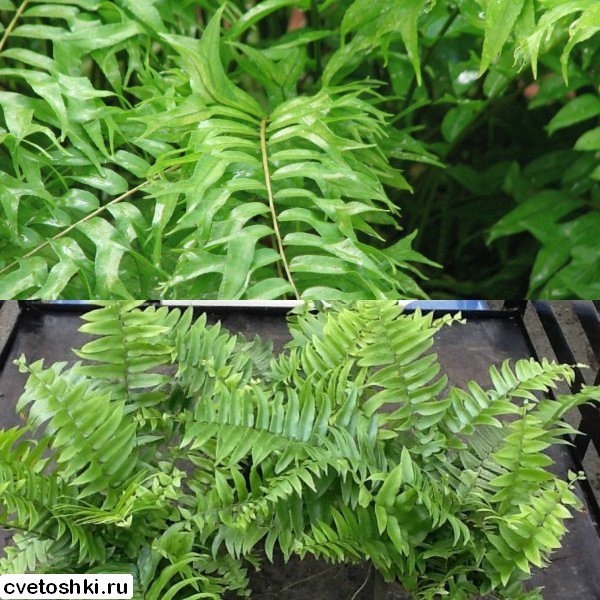

All xylenes and formaldehydes emitted by finishing materials, furniture products, decorative elements are effectively and efficiently removed using these colors. Cleansing the air from harmful substances is one of the most important advantages of such a fern. In addition, there are practically no allergic reactions to them, unlike other ferns.
Numerous growers and breeders separately respect this plant for the opportunity to experiment with different species. Thanks to various types of crosses, new forms of flowers are constantly being developed - with pinnately-separate, openwork leaves, which are called "vayi". Look at examples of nephrolepsis breeding in the photo
Description and varieties
Many species are able to easily survive various natural disasters, as well as survive in the most difficult conditions. Some of these species are fairly simple to grow at home. But if you want the fern to delight you with its healthy and luxurious appearance, you must follow some rules for caring for this plant. That is why let's take a look at how to care for a fern at home.
Absolutely all species are perennial terrestrial epiphytic plants. They have short rhizomes and pinnately dissected leaves. The entire stem is strewn with leaves. In addition, ground loops are formed on the stems, which, in time of contact with the soil, are able to give roots rather quickly. On the lower part of the leaves are sporangia.
Currently, science knows more than 10,000 species of aquatic, herbaceous, terrestrial and tree ferns. Depending on these divisions, bushes can grow in meadows, swamps or in the forest. Among these species, you can find both giants and very little ones. The length of the leaves of large fern species can be up to half a meter. These moisture-loving shrubs have very delicate leaves that are heavily dissected and have a light green color. Drought-resistant species have leathery leaves, on which a waxy coating can sometimes be found.
Main types
Currently, there are many different species that are suitable for home cultivation. Let's consider the most popular ones:
- Nephrolepis. This species is the most unpretentious in terms of care, it is also popular among other types of domestic ferns. The plant has a spectacular rosette, which is formed using openwork leaves with spores on the inside. The length of one sheet plate can reach 50 cm.
- Davallia. This species is popularly called the hare's foot. The bush is distinguished by the presence of reddish and shaggy rhizomes that hang along the edges, grows in hanging pots. This exotic species has very beautiful juicy green leaves.
- Platizerium. This bush is a plant with flat leaves that grow in different directions and outwardly strongly resemble deer antlers. The middle of the plant with brown leaves is very similar to a cabbage head.
- Asplenium. This plant is also called kostenets. The main difference from other types of fern is the presence of undivided leaves wavy along the edges. It is worth noting that this species does not tolerate when its leaves are touched.
- Blehnum. This species is called Derbyanka. The structure of the fern resembles a palm tree. An adult plant can reach 1 meter in diameter, its crown consists of tough fringes.
- Disconia. As a houseplant, this species can be grown at home only at a young age. After a few years, the fern of this species turns into a tall tree, the height of which can reach up to 6 m.
- Polypodium. This species is popularly called the centipede. Plants are distinguished by the presence of deeply dissected leaves, which are located on thin stems. The fern rhizome crawls and clings to the surface. This type of shrub can easily grow in the air.
Reproduction
As a rule, the fern bush is divided in the spring, when it is necessary to transplant. An important point should be observed - an exceptionally large and adult flower with numerous processes is divided. Delenki are seated in a separate container and watered.


For reproduction of nephrolepis by offspring, you need to take the mustache aside and dig a little into a small container with soil. The tops are located above the surface.
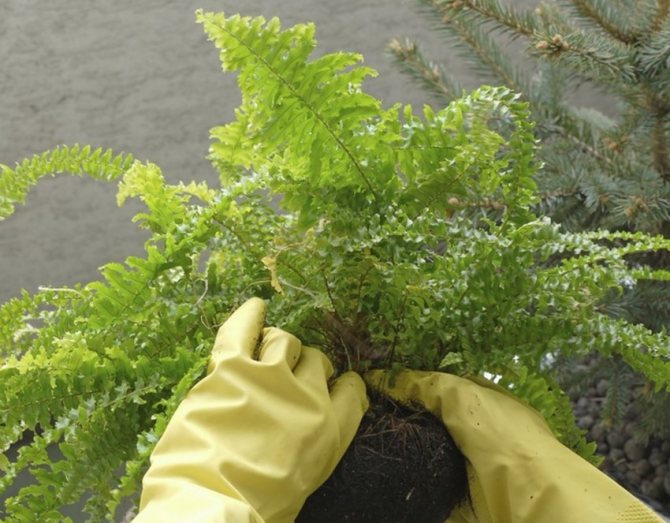

The soil should always be slightly damp in order for the offspring to root well. Shoots will appear in a month. When they get stronger, they can be separated and transplanted.
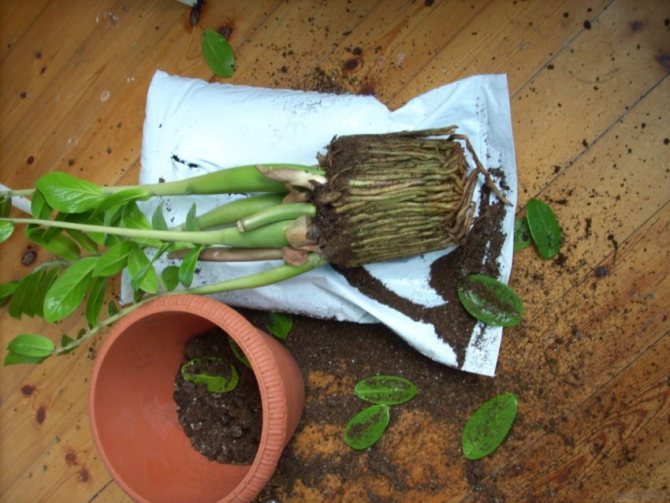

Why does fern turn yellow in indoor conditions
Symptoms of the development of fern diseases
| On the underside of the leaves of many indoor and garden fern species, clusters of brown dots or stripes with small dust-like formations can form inside them. These are the reproductive organs of ferns, usually they are located in a strictly defined order, and are not some sign of illness or a dangerous pest; thus, many fern species naturally reproduce. Figure # 1. Sporangia with spores located on the underside of the leaves of an adult fern | $ IMAGE1 $ |
Appearance of spores of various fern species:
When even the slightest, unnatural for healthy plants, signs appear, you need to study the symptoms with special care and urgently take all necessary measures, without waiting for further development of damage.
.
Transfer
Nephrolepis needs an annual transplant. The ideal time is spring. An adult fern will need to be transplanted every three years. The flower loves space.
If it is large and the pot is too small, then you definitely need to transplant it. It should be planted in mixed soil (peat and coniferous). The bottom of the pot is covered with pebbles. It will serve as good drainage and excess water will drain away. Pebbles are used to prevent waterlogging of the soil.


Maidenhair adiantum
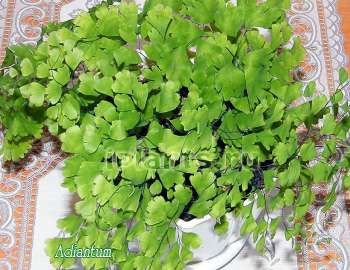

Maidenhair is one of the most beautiful indoor plants. This fern has very delicate leaves with thin, dark, wire-like petioles and segmented leaf blades with rounded edges. Among several varieties of maidenhair, the most beautiful is Tenerum Farleyense, the most common is Capillus Veneris. There are variegated varieties with yellow-green and orange-red color of pinnately dissected leaves.
Maidenhair plants belong to the plants of moderately warm rooms, i.e. the acceptable temperature range for them is from 12 to 25 degrees (ideally, if the temperature ranges from 15 to 20 g.). During the strong summer heat, it is better to remove the plant from the windowsill, because this is the hottest place in the room, even if the window is north. The coolest place on the floor. Direct sunlight is contraindicated in maidenhair, as in all ferns.
The plant does not tolerate overdrying at all. They forgot to water it on time, and in just a couple of days all the leaves will turn yellow and then begin to dry. Not a single living leaf may remain in the pot, but do not rush to throw the plant away. It is necessary to cut off all dried or yellowed leaves, lower the pot into a vessel with lukewarm, settled water, so that the water level reaches the level of the soil in the pot, when the water soaks the soil well, the plant is removed, the excess water is drained and placed on a dry tray.
After a few days (depending on the temperature), the first green curls will appear, and over time, the maidenhair will fully recover and become a curly handsome man again. This is the beauty of this plant - just a phoenix! Maidenhair loves regular watering, but at the same time, like most plants, it suffers greatly from excess moisture and begins to hurt. Excessive moisture in the pot is especially dangerous when the apartment is too cold or too hot.
Caring for the Maidenhair - in the section of the Encyclopedia of Houseplants.
So that the roots of the plant do not rot, be sure to drain expanded clay at the bottom of the pot, water must be poured slowly, in portions, until its excess appears in the pan.If after 20-30 minutes the water from the pan has not been absorbed back into the pot, then it must be drained. How to make sure that there was enough water during irrigation (it could simply drain along the walls without wetting the earthen lump)? This is easy to do if you raise and evaluate the weight of the pot before and after watering; after watering, the pot should be significantly heavier.
When the plant is healthy, the soil dries out pretty quickly and you have to water it often. As soon as the maidenhair begins to lack moisture, its beautiful leaves become dull, in this case, watering is best done by immersing the pot with the plant in warm water, as mentioned earlier, otherwise it is difficult to wet the soil in the pot, which is typical for almost all ferns. Watering should be reduced as daylight hours decrease. With a lack of light, the leaves of the maidenhair stretch out and their fan-shaped segments become smaller, which leads to a loss of decorativeness.
Maidenhair do not tolerate spraying well, although they do not like the dry air of rooms with central heating, so you need to make sure that the jets of hot air rising from the battery do not fall on the leaves. If the plant is affected by fungal or bacterial diseases, then treatment by spraying it with appropriate chemicals will only worsen the situation. In this case, you need to remove all the affected parts of the plant, transplant it into fresh soil, burying several pieces of charcoal or activated carbon tablets from the pharmacy into it. Chemicals can only be used when watering. For the same reason, pest infestation of the maidenhair must be avoided. The formation of black tubercles along the edge of the leaf blade of a mature leaf is not a disease or pest, these are spores characteristic of all ferns.
The maidenhair is bred by dividing old bushes. The soil can be used as usual, the same as for other decorative deciduous plants. When transplanting, it is not necessary to deepen the maidenhair, more than the original ground level. Top dressing can be carried out only a year after transplantation; maidenhair does not tolerate excess nitrogen. From May to September, you can feed with liquid fertilizer once a month, in doses that are half of the norm indicated on the label.
Location and light
A bright but diffused luminous flux is required, while a slight shadow is not excluded. Direct streaks of light will cause burns. In this regard, its location on the south side will be incorrect.
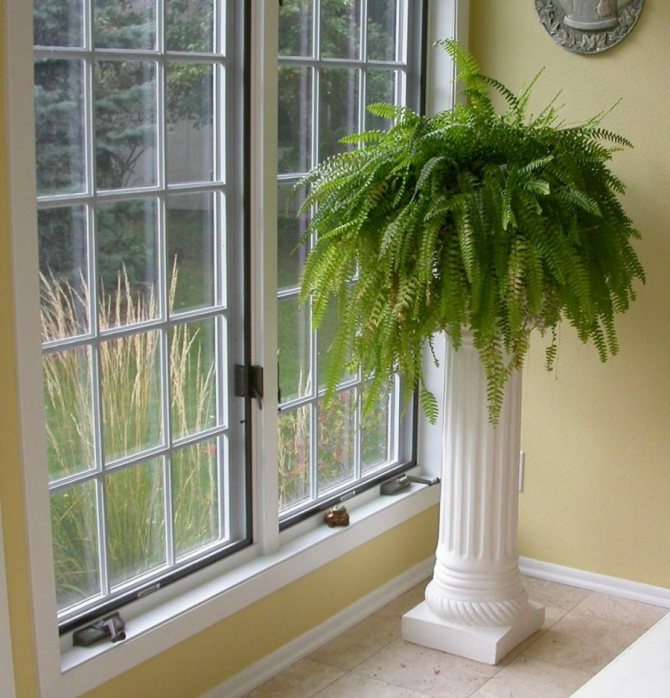

But if this is the only possible place, then at least increase the distance from the window. Artificial lighting is also helpful. Especially when it gets dark early on the street.


Moisture contents
Air humidity is a significant factor and a guarantee of longevity of a fern representative. Maintaining comfort involves the daily application of water from a spray bottle.
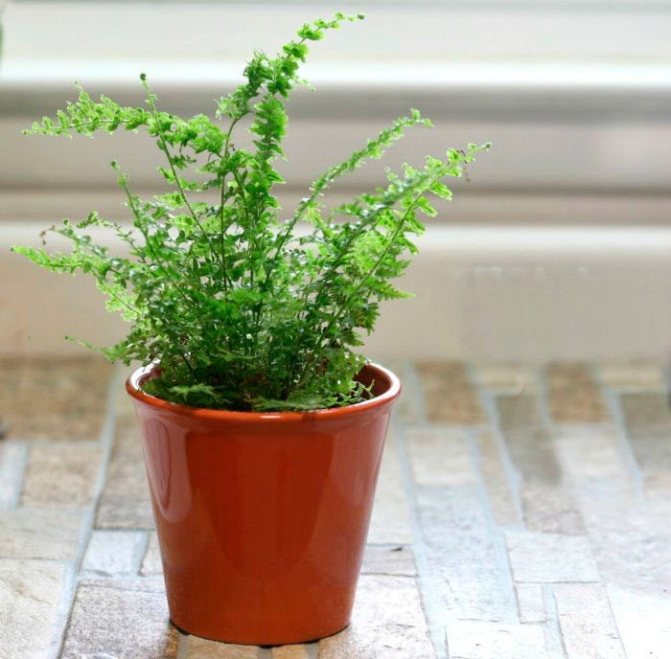

On too hot days, the procedure is repeated 2-3 times, and every four weeks you can organize a shower, having previously covered the top ground layer with a film, in order to avoid waterlogging.
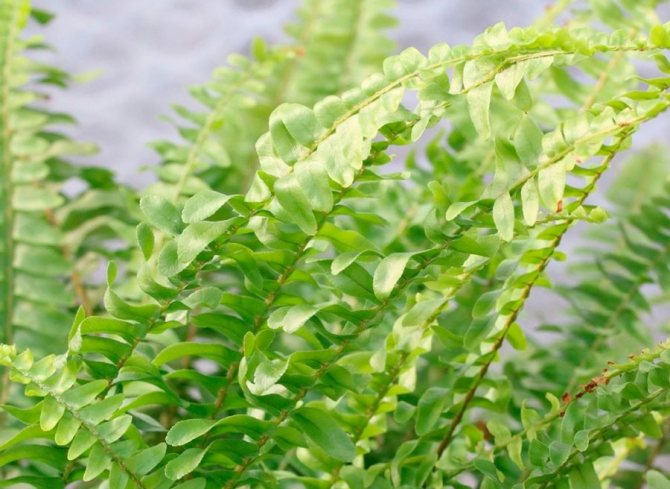

Features of the fern nephrolepsis
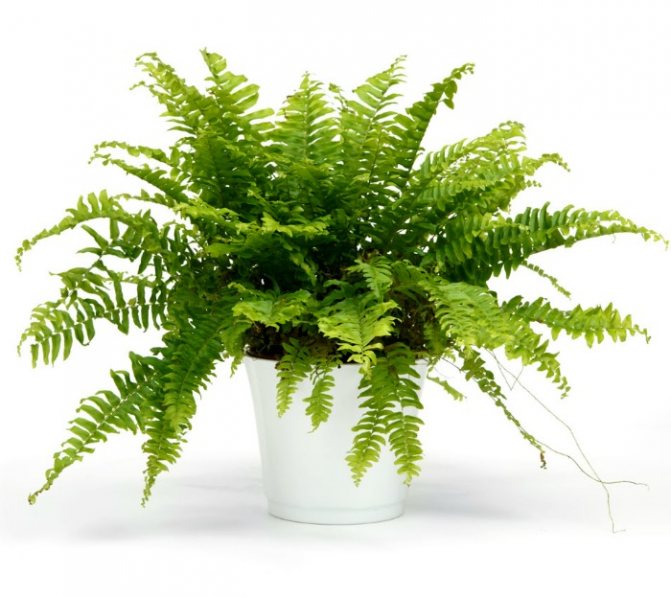

The herbaceous plant nephrolepsis can be terrestrial or epiphytic. Its rhizome is relatively short. The rosette includes greenish pinnate leaf plates with short petioles, their length is about 0.7 m.The plates include serrate-crenate lanceolate segments along the edge, their length is about 50 mm, on their seamy surface on both sides of the median vein are located rounded sori. Over time, the leaf plates turn yellow and die off. Leafless shoots extend from the rhizome, the surface of which is covered with scales. Such shoots quickly give roots when rooting.
Views
There are indoor nephrolepis about 30 types and many varieties, for example:
Exalted
The most common variety. Both pot forms and ampelous ones are grown. In nature, it is an epiphyte.The plant is located on a high erect stem.
Photo of the subspecies Nephrolepis Exalted:
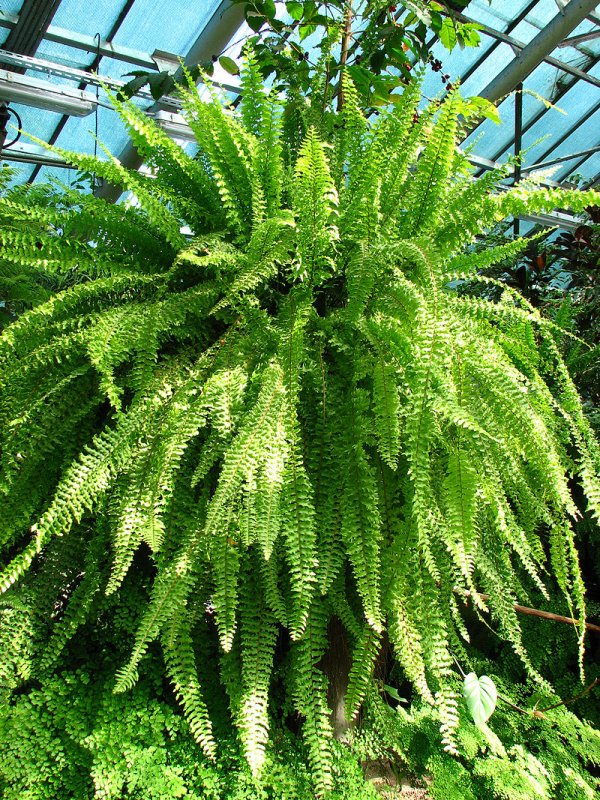

Hearty
The leaves of this representative of nephrolepis are located almost vertically. There are tuberous cones on the shoots underground.
Photo of the subspecies Nephrolepis cordialis:


Green Lady
An ampel plant is considered one of the most beautiful ferns: long stems hang freely in the form of a fountain, leaves are delicate, slightly curled. Especially spectacular this fern when standing alone on a high stand.
Photo of the subspecies Nephrolepis Green Lady:
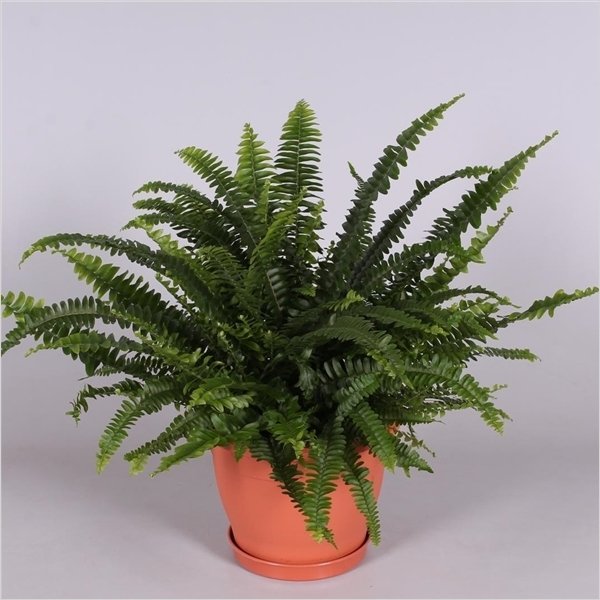

Xiphoid
Its leaves reach a length of one and a half to two meters. In nature, it is common in Florida and on the tropical islands in the Atlantic. In the rooms it is grown as an ampelous plant.
Photo of the subspecies Nephrolepis Xiphoid:
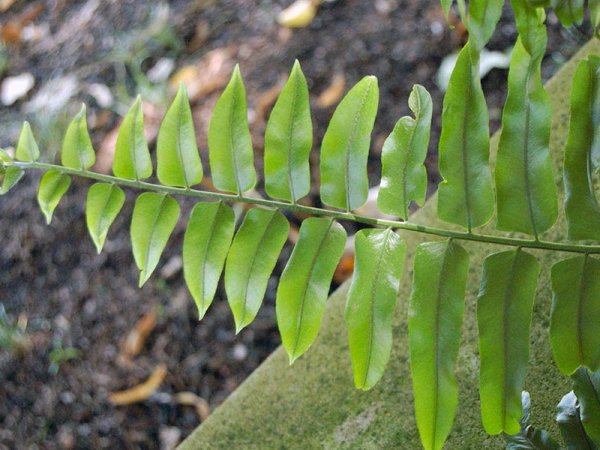

Boston
It was obtained about 100 years ago as a result of selection from the xiphoid fern. He has drooping curly fronds, rich greens. There is 10 varieties Boston nephrolepis.
Photo of the Boston Nephrolepis subspecies:
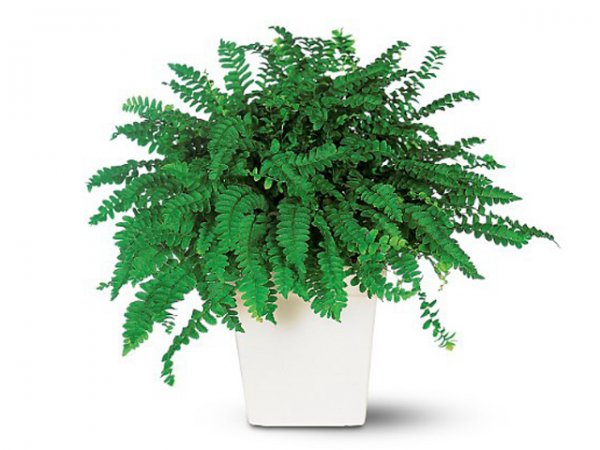

Corditas
A variety of sublime nephrolepis, is of interest for indoor floriculture, since it is a rare species of terry fern with slightly curly raised vaults.
Photo of the subspecies Nephrolepis Corditas:
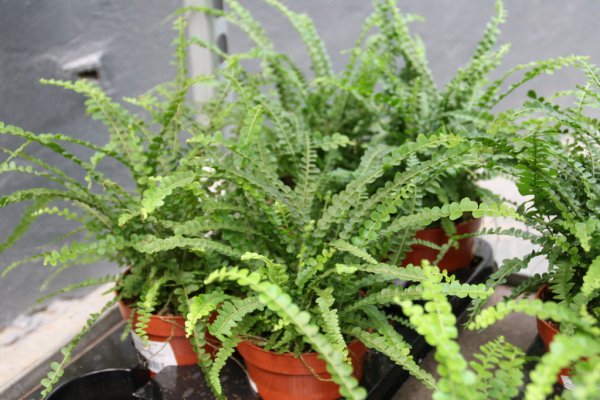

Curly
With wavy and curled leaf edges, very decorative.
Photo of the subspecies Nephrolepis Curly:
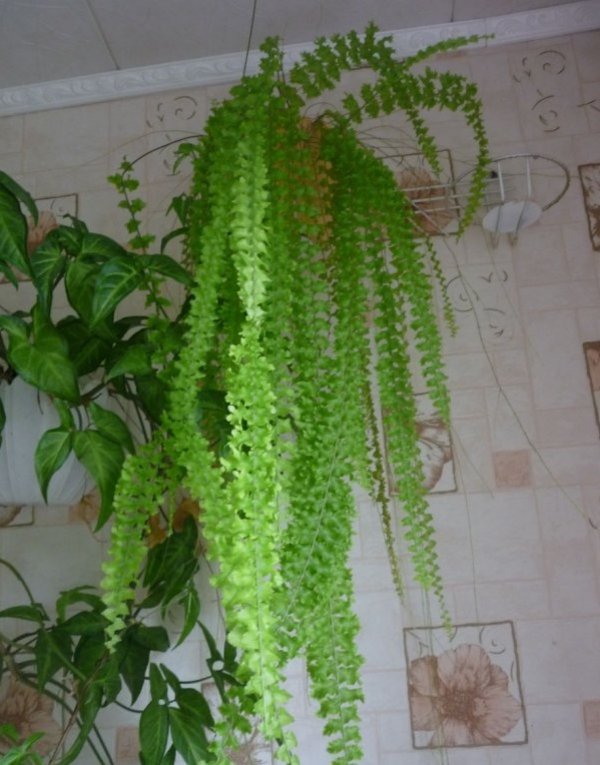

We talked more about the common types of ferns in this article.
What or who caused the disease
Growth problems and the way the fern looks can be caused by some of the pests that parasitize it.
- Insects of the Hemiptera family, or scale insects, attack the shoots from below, and destroy the leaves. A thorough examination will help prevent their appearance. If they appear, then they should be collected and destroyed, and the flower should be sprayed with an organophosphate insecticide.
- Aleurodids or whiteflies. If they appear, it becomes clear why the leaves are drying. To prevent this process and fight the parasite, a water-alcohol solution is used.
- Felters. A sign of the presence - small white lumps on the internodes. To eliminate the problem, moisten a cotton pad with alcohol and get rid of lumps. The fern itself is wiped with a soap-based solution, and a little later, it is also treated with a chemical.
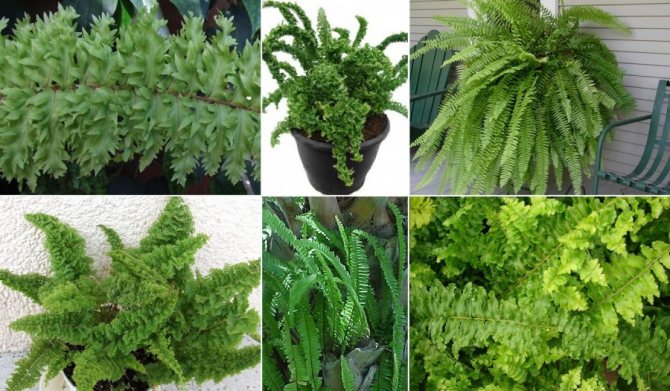

Excessive moisture or improperly selected soil mixture often provokes the occurrence of various diseases. Most often, there are fungal or bacterial infections, root rot. For treatment, a transplant is needed with the treatment of the root system with agents to combat fungi and bacteria.


IMPORTANT!!! Do not wait for flowering after purchase. This plant does not bloom!


1. Seven Secrets of Success:
| 1. Growing temperature: throughout the year, moderately warm content at a temperature of 16 to 18 ° C. |
| 2. Lighting: Well-lit location shaded from direct sunlight during daylight hours. When grown in partial shade, it will also feel great. |
| 3. Watering and humidity: Keep the soil evenly moist, but not waterlogged at any time of the year. The plant does not tolerate dry air of heated rooms - by any means try to maintain the humidity at a high level. |
| 4. Features of the: Nephrolepis is able to decorate any interior with itself, but to maintain health, it needs regular watering and high humidity. |
| 5. Priming: nutritious and well-drained soil with acidic pH and a lot of leafy and soddy soil. |
| 6. Top dressing: at any time of the year, plants are fed with mineral or organic fertilizers every 2 weeks. |
| 7. Reproduction: by division when transplanting, by small daughter ferns, vegetative shoots and sowing spores in spring. |
Botanical name: Nephrolepis.
Family... Davallievs.
Fern nephrolepis homeland... Southeast Asia, Central America.


Description... A diverse genus of ferns that consists of evergreen or semi-evergreen, epiphytic or terrestrial plants. The rhizome is short, thick, covered with brown scales. The dense, lacy frond of this fern reaches a length of 2 meters and falls beautifully downward. The leaves are arranged alternately, light green, triangular. Sporangia are located under each leaf on the underside. From time to time, plants will release long leafless shoots with scales on the surface, which are easily rooted in the substrate.


Height... When grown as a houseplant, it reaches a height of 50 cm. The fronds range from 30 to 90 cm in length.
↑ Up,


You may also be interested in:
- Chlorophytum - photo, home care, plant propagation, species, soil for growing in a pot, transplanting, watering indoor plants
- Tsiperus - flower photo, home care, reproduction, description of plant species, composition of soil for growing, signs and superstitions associated with indoor plants, growing from seeds, transplanting
- Dracaena - photo, home care, types, reproduction, transplanting room dracaena, watering the plant, flowering, pruning, diseases and pests
- Asparagus - photo, home care, description of species, plant reproduction - growing from seeds, why asparagus turns yellow, transplanting, flowering time, soil composition for keeping in a pot, signs and superstitions associated with the plant
↑ Up,
Nephrolepis in nature and on the windowsill
Nephrolepis is a fern that flower growers fell in love with for its unpretentiousness and lush greenery of the bush. Like all indoor plants, nephrolepis came to us from the wild. Plants of this family have chosen tropical forests for their habitat, which are found on any continent. There are not so many varieties of nephrolepis - only about 30, only a few of them are domesticated and can grow in pots.
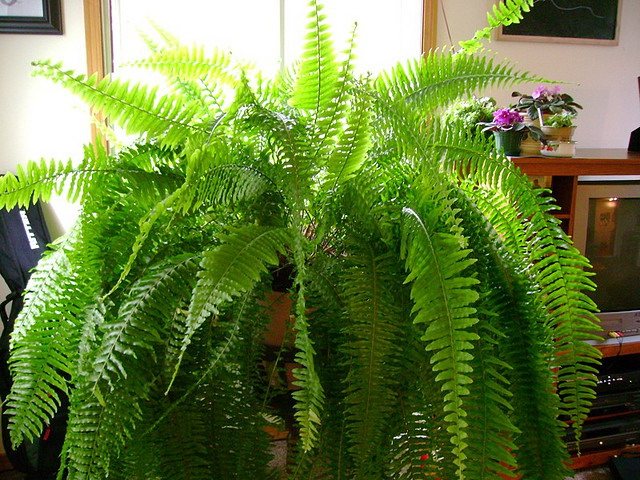

Nephrolepis is a genus of ferns native to tropical forests
The name of the culture comes from two Greek words: nephros - bud (meaning sori with spores on the back of the leaf) and lepis - scales (veil, stipule covering the sori).
The frond is a large, feathery, leaf-like part of the fern, composed of many stipules.


On the back of the stipules are buds with spores (sori)
All ferns live in forests, that is, in conditions of diffused light and shade. This habitat is also characterized by high humidity and loose fertile soil. All this is not difficult to create in an apartment. Nephrolepis grows well even away from windows, for example, on cabinets, tables, in hanging pots. Flowers respond well to fluorescent lights, so they can be seen in hotels, offices, schools and clinics.
Because of the complicated foreign name, Russian flower growers call nephrolepis in their own convenient manner: nephrolOpes, nephrolepSis, or simply - home fern.
Video: nephrolepis for decoration and relaxation
Possible difficulties
Nephrolepis is resistant to plant diseases, but can suffer from parasite infestations. Most often, he is bothered by a spider mite, whitefly or aphid. Indoor ferns are not often infested with parasites. Pests attack only those plants that are on the street or near other infected flowers. Hot weather is especially dangerous when the air becomes too dry. Treatment with an insecticide according to the instructions for the drug helps to save nephrolepis.
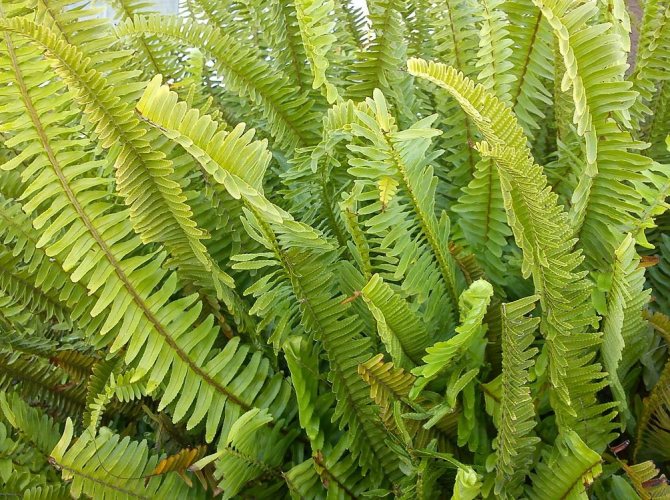

A number of problems can be resolved by changing the conditions of detention. Here are the main problems that growers face and ways to solve them:
- the edges of the leaves dry up - you should spray the plants more often;
- lethargic and wilted fronds indicate insufficient watering;
- leaves lose their rich color and become translucent - the plant is in a too bright place;
- brown or yellowing leaves - the air temperature is too high;
- slowing down or stopping growth in spring and summer - lack of fertilizer, poor soil or too tight a pot.
Mr. Dachnik informs: nephrolepis - protection from electromagnetic radiation
You can not only show off the decorative appearance of the bush in front of guests.
There is a sign that Nephrolepis has a beneficial effect on the energy of a person, keeps a calm atmosphere in the house. If placed on the north side of the room, it will bring success in your career.


Green Lady
The plant purifies the air in the room, which is good for health. If the pot is placed near a computer or TV, the fern will absorb electromagnetic radiation, protecting all family members from it.
Stages
A drain is placed in a disinfected container. Then the flower is carefully removed from the old container, carefully removing the excess soil. It is obligatory to check the roots in order to separate the rotten segments, if necessary, and to treat the damaged areas with crushed coal.
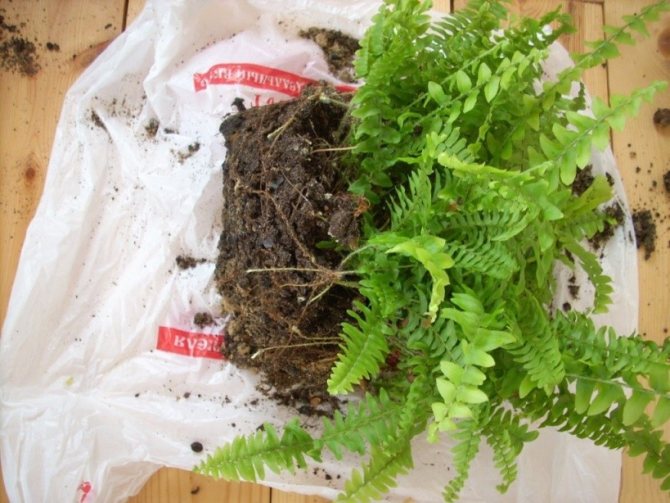

Further, the culture is placed in a new dwelling and covered with fresh soil. The deciduous part remains above the soil.


The fixing procedure is watering. When purchasing store-bought soil, they prefer lightweight mixtures.


For self-cooking, you will need peat, earth with rotted components and sand in a ratio of 1: 4: 1. The resulting composition is diluted with bone meal and charcoal particles.
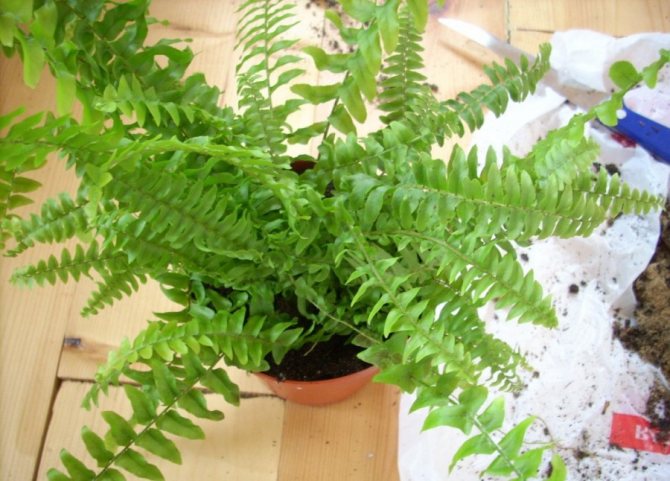

Possible diseases
The main pest that can destroy the plant is the scale insect. At the first signs of its appearance on the fern, treatment with a special chemical agent is carried out.
But during sporulation, the presence of brown dots and stripes is not a disease.
Pale leaves, dark spots may indicate a lot of light. In this case, the plant must be rearranged in the shade and sprayed abundantly.
An excess of moisture in the ground is indicated by rot on the leaves. To get rid of it, the soil must be dried, and then watered in the required mode and quantity.
general information
The ancestors of nephrolepis appeared during the life of dinosaurs. The plant has a compact rhizome; in some species, small growths (tubers) can be found. They contain a supply of nutrients. In case of hunger, the plant will receive important elements for development from the tubers.
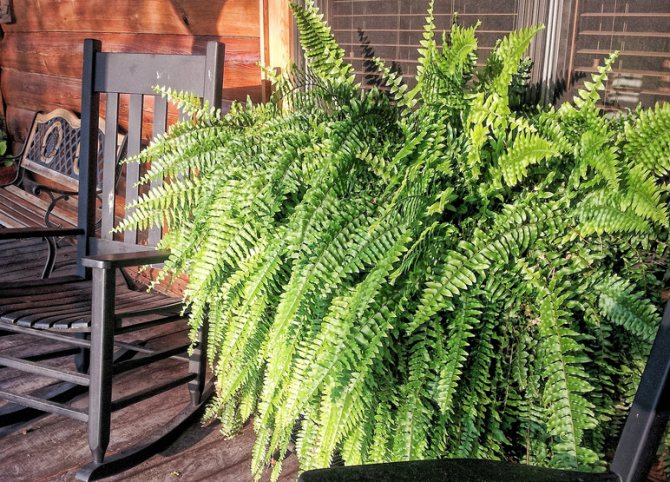

Herbaceous perennial fits into a wide variety of interiors
The aboveground part is a green mass. Leaves (fronds) are long rods with many emerald, dark green, gray-green or blue-green segments. On the reverse side of the feathers there are rounded projections. They contain clusters of fern spores.
Another component of the aerial part is thin whip-like shoots. There are no leaves on them.
Plant reviews
This is one of the most unpretentious ferns, a very effective plant. I love this unpretentious indoor fern dearly. In September, she planted a huge bowl-like pot, and everyone was gifted with a fern. But it took me a long time to grow well. At first I managed to get a plant of three half-leaves, around which I didn’t dance with a tambourine, I really wanted a big beautiful fern. But my dancing did not touch him in the least, and he stood at the same time, apparently wondering whether it was worth living. And so, digging up the Internet in search of an answer to what he needs, I came across a recipe that I want to share. For transplanting, the land must be very generously diluted with pine bark. We also add pieces of coal, coniferous litter, you can add sphagnum. It will not hurt to mix in sand if the land is purchased, otherwise there is, as a rule, one peat. And it is better to take a pot flat, and not high. Transplanted in this way, my scum somehow recovered very quickly and started growing, and now there are no problems with him. But he does not like drying out, and it is better to monitor the moisture of the earth. After all, it stands high, and the fact that it is dry is not immediately noticeable.The fronds do not fade, but simply turn pale somehow and begin to dry at the tips of the leaves. But the saddest thing is that the "snails" dry up before they could turn around. A beautiful home plant, unpretentious and grateful for its care, I recommend it!
irkin44
I have the same. It is necessary to rearrange the window, otherwise the leaves are long and sparse. But when he fluffs up - oh and handsome! All guests drop in.
Elf
I have had ferns for a long time, 15 years for sure. I am always surprised when you complain about the lack of light for them. In my experience, they are beautiful and green only in winter. As the spring comes - the sun, they begin to fade. If I take them out into the yard and on the completely shady side, where the sun never hits them, it’s the same. Become pale. Here are mine on the veranda in winter, I have already taken them off and hid them in the northern rooms.
jiquet
I adore this plant for its luxurious dense greenery, for an interesting observation of how a beautiful carved frond appears from "snails", and so on ad infinitum! Every now and then my little children came up, waited for green, furry balls to appear on the surface of the earth, which change in size every day. The plant survives well enough. But if you want it to be a juicy green, you need to create favorable conditions for it. The main thing is not to pour, often spray with settled water, not to feed with fertilizers, it is enough to fertilize twice with liquid fertilizer for decorative flowering plants. In very bright light, nephrolepis fronds turn pale, so you do not need to put it on the southern window. But in the shade it also fades. The most successful window will be the east one. In the New Year we decorate it with rain, it looks very original. A very nice lush fern.
Clarice
I love ferns, at my summer cottage I have several of them. Maybe that's why I also like nephrolepis, because he is also a representative of ferns. Awesomely beautiful at home. It is not difficult to grow it, it grows very quickly and is unpretentious. Prefers moist soil, loves spraying, grows well in partial shade, fertilizing is needed from time to time.
Anna Zakharchuk
Lighting: one of the conditions for growing nephrolepis
Despite the fact that nephrolepis, like most other ferns, is a shade-tolerant plant, it needs light, especially in indoor conditions. If the windows face south, and the room is bathed in sun for most of the day, you can place the fern away from the window. The main condition - a lot of light without direct sunlight must be observed.
With a north orientation, nephrolepis will feel good on a windowsill or close to a window. The lack of light affects not only the appearance of the plant, but also the development in general. A loose rosette with rare fronds, pale greens, weak growth are signs of a lack of lighting.
Air humidity level
Nephrolepis is a plant that loves moisture. If you maintain a moderate temperature in the room, then even dry air will be carried by the fern without any problems, subject to timely watering and periodic spraying. If the temperature is elevated, spraying should be carried out daily. Soft water is good for this. In order to help the fern withstand the heat, it can be removed to an area where deep shade prevails. In this case, the pot must be placed on a pallet, previously covered with moss or expanded clay, into which, further, you need to periodically add water.
If the air temperature, on the contrary, is lowered, then you need to ensure that the plant does not overcool, and the development of a fungal or other disease does not begin.
Brief description of cultivation
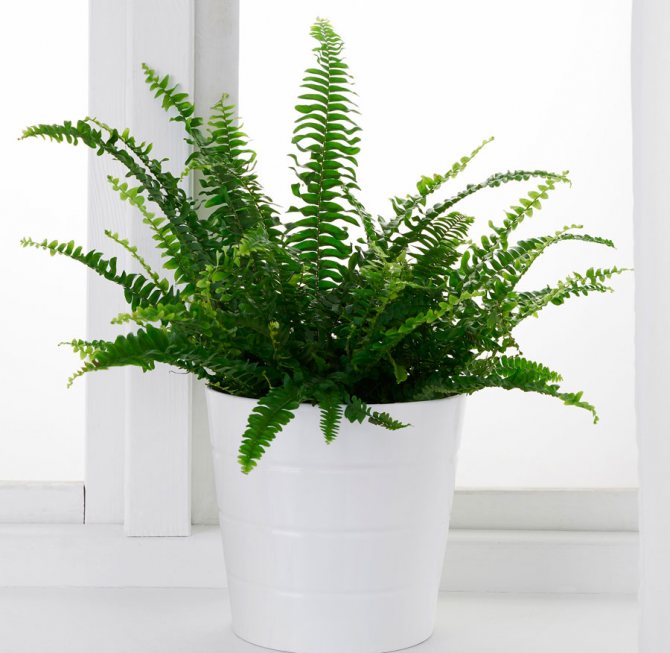

- Bloom... Such a fern does not form flowers.
- Illumination... Sunlight must be diffused. The pot is placed near a window of a western, northern or eastern orientation.The duration of daylight hours required for such a plant is from 14 to 16 hours.
- Temperature regime... During the growing season - from 20 to 24 degrees, during the dormant period - about 15 degrees.
- Watering... The frequency and abundance of watering is affected by the air temperature in the room. So, the cooler the room, the less water the plant needs. Remember that between waterings, the surface of the soil mixture in the pot must dry out.
- Air humidity... It should be elevated. To do this, the bush is regularly and quite often moistened with a spray bottle, systematically arrange a shower and set the pot on a tray filled with wet pebbles.
- Fertilizer... Top dressing is carried out in March – September at intervals of 3 or 4 times a month. To do this, use a complex fertilizer for ornamental deciduous plants. If the bushes are warm in winter, then they will need to be fed once every 30 days.
- Dormant period... In October – February.
- Transfer... Young bushes are transplanted every year, and older specimens are transplanted once every 2 or 3 years.
- Reproduction... Such a fern can only be propagated by vegetative methods, namely by shoots, offspring and dividing the bush.
- Harmful insects... Aphids, whiteflies, spider mites, root worms and scale insects.
- Diseases... The plant can lose its spectacular appearance due to excessively low air humidity or improper care.




